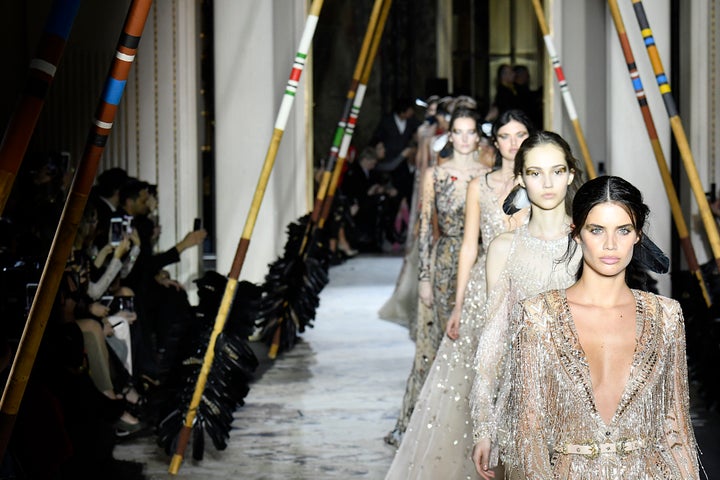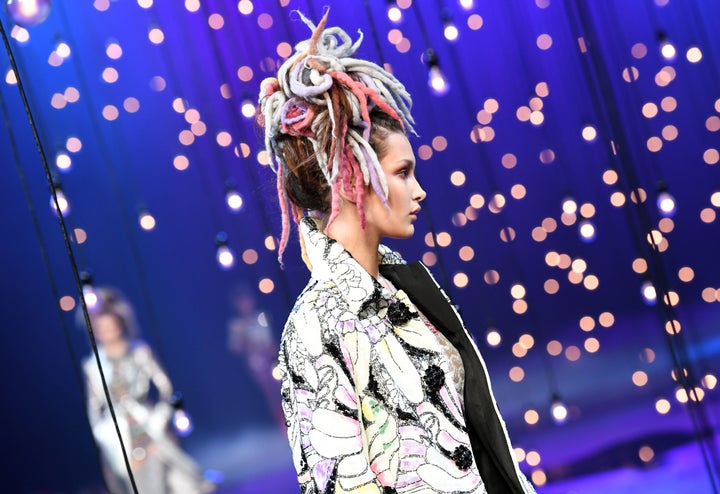
Last month, during Couture Fashion Week in Paris, Zuhair Murad became the latest fashion figure to be accused of cultural appropriation.
The Lebanese designer, whose garments have been worn by stars like Jennifer Lopez and Kristen Stewart, created a beautiful collection ― but it incorporated Native American imagery in a way that left a lot of people uncomfortable.
Many of the garments featured details and accessories (like feathers in the models’ hair) that appeared to reference an “outsider’s view of many Indigenous cultures,” as Teen Vogue wrote. Then there was the social media promotion, which included the hashtag #IndianSummer. Finally, Murad’s fashion show set included large painted poles arranged to look like teepees without coverings.
Murad offered a statement in response to the criticism, saying, “The house pays homage to the craftsmanship of an array of ancient tribes, notably the Sioux, the Navajos, the Iroquois, and celebrates their traditional prints, embroideries, and pictograms.”
While Murad credited the indigenous tribes for his inspiration ― something that many brands fail to do ― his statement obviously wasn’t perfect. (More on that later.)
As we gear up for fashion month, with New York Fashion Week kicking off Thursday, perhaps it’s time for a refresher on the difference between appropriation and appreciation. Designers, bloggers, models and everyone else, please take note.

What is appropriation, again?
As HuffPost has written before, the Cambridge Dictionary defines cultural appropriation as “the act of taking or using things from a culture that is not your own, especially without showing that you understand or respect this culture.”
For example, it’s disrespectful to the indigenous community to send a lingerie-clad model down the runway with a feathered headdress. Vogue publishing photos of a white model in geisha-inspired outfits ― in its diversity issue, no less ― probably isn’t the best way to pay homage to Japanese culture. And for everyone’s sake, don’t present a bunch of white models sporting locs, and then apologize for your “lack of sensitivity” by saying “Funny how you don’t criticize women of color for straightening their hair,” a la Marc Jacobs.
LeRhonda Manigault-Bryant, associate professor of Africana studies at Williams College, provided a more nuanced explanation of cultural appropriation, telling HuffPost, “It’s actually really hard to define, and I think that’s part of what makes it so complex.”
“I think of it, in the most rudimentary terms, as this very fluid exchange of culture that happens among human beings,” she went on. “But the way that we think about it, especially now, is that it refers to taking someone else’s culture ― intellectual property, artifacts, style, art form, etc. ― without permission.”
When is appropriation bad?
As Fordham University law Professor Susan Scafidi told Jezebel in 2012, appropriation is “most likely to be harmful when the source community is a minority group that has been oppressed or exploited in other ways or when the object of appropriation is particularly sensitive, e.g. sacred objects.”
To expand on Scafidi’s point, look at Kim Kardashian’s recent “Bo Derek braids” controversy. Kardashian, who is inarguably privileged, posted an image of herself wearing cornrows, crediting Derek as her inspiration. But cornrows, a hairstyle very much associated with black culture, have a complicated history that goes back further than Derek.
As Manigault-Bryant pointed out, Kardashian wearing braids “becomes a kind of symbol of beauty in some ways.” But black students have been punished for wearing similar hairstyles. That double standard, she said, “complicates the idea of appropriation.”
Derek responded to the controversy by arguing that cornrows “are just a hairstyle” (which, again, isn’t true for many people) that she wore for a movie, the 1979 film “10.”
However, Derek also acknowledged on Twitter that she’d copied the hairstyle “from Ann-Margret’s backup singer from her Vegas Sho [sic].”
“And we all copied Queen Nofretari. I hope Her Royal Highness is flattered,” she wrote. (Derek’s mother was a makeup and hair artist for Ann-Margret, the Swedish actress, when Derek was young. People magazine notes that “Derek might be referring to the Egyptian Queen Ahmose-Nofretari, sometimes known as Ahmose-Nefertari, who was buried with braids.”)
That acknowledgement by Derek, Manigault-Bryant explained, is “a critical piece” of information when it comes to appreciation vs. appropriation.
At the same time, Derek was late to acknowledge her inspirations ― not unlike Murad, who cited “the Sioux, the Navajos, [and] the Iroquois” in a statement after his fashion show had already happened. “Nobody should have to remind you to say where you got something from,” Manigault-Bryant told HuffPost. “It shouldn’t be an afterthought.”
“Imitation is the best form of flattery,” she said. “Most people believe that and agree with that, and yet if you’re imitating something but you’re not actually giving credit where credit is due, in academic communities we would call that plagiarism.”
Can designers borrow respectfully?
What, aside from not using other cultures as the heart of their collections, can designers do if they face such accusations? In 2018, is an apology enough?
For one thing, designers should be transparent about their inspirations from the get-go.
“We are absolutely inspired by other people all the time ― academics included,” Manigault-Bryant said. “But there’s no way I could make a living and not actually cite or invoke by name the people who inspired me. We should not intellectually or culturally plagiarize. We should truly get in the business of paying honor and homage where it’s due.”
“There needs to be increased diversity of all the various forms to make sure these kinds of things aren’t happening,” she added.
And from a public relations perspective, Ronn Torossian, a PR professional and founder of 5WPR, told HuffPost, “Brands need to be conscious of their audience; they need to be conscious of the political time that we live in.”
There are brands that seem to be doing things right, or at least moving in a positive direction. There’s the Brazilian sportswear label Osklen, which took inspiration from the Asháninka, an indigenous people who live in the Brazilian and Peruvian rainforest, for its spring 2016 collection. Osklen paid the tribe in order to use aspects of their tattoos and traditional fabrics in its collection. With the money, the Asháninka were able to build a school and open a store to sell their artisanal products.
Then there’s Gucci’s recent collaboration with the Harlem designer Dapper Dan (real name Daniel Day). Some accused the Italian label of copying Day, who made a name for himself in the ’80s and early ’90s by repurposing designer goods into new garments. In response, Gucci creative director Alessandro Michele said Day was among his inspirations, and later made him the face of a Gucci campaign. Gucci and Day also collaborated on a store in Harlem to sell made-to-order garments.
“Giving credit is one thing, but being included from the onset is also important,” Manigault-Bryant said.
At the very least, when brands are called out for crossing the line from appreciation to appropriation, they need to own up to their mistakes and offer a sincere apology.
“A good apology is always telling the truth. A good apology is owning up. A good apology is moving quickly. And a good apology is authentic and real and isn’t fabricated,” Torossian said. “It needs to come from the heart.”